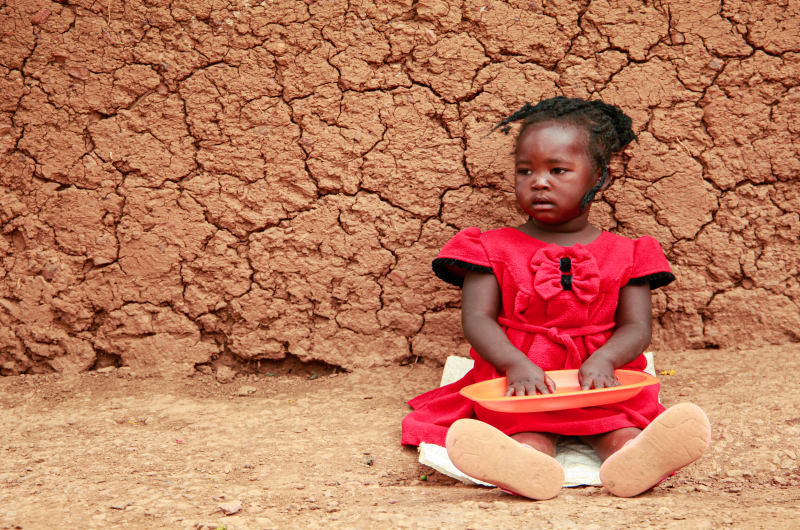Big brown eyes blink up at Thamilselvi as they ask, “Why can’t we have chicken, amma?” “Why is there no milk in my tea, amma?” “Why can’t I have a biscuit, amma?”
Thamilselvi doesn’t have the answers to her children’s questions. The truth is that hunger has changed everything in their home.

Thamilselvi is in her kitchen with her two boys, Vengadeshwaram (left) and Vishal (right).
“When they keep asking me for things I can’t give them, it’s so hard for me,” she says. “I have to go abroad to work. At least then my children will get three good meals a day if I send money.”
Thamilselvi’s family is just one of many families in crisis, having to make desperate decisions and life-threatening sacrifices. The current global food crisis is unlike any food crisis in the past because of the unique factors contributing to it—conflict, inflation, drought and the pandemic to name a few. This is a crisis that is impacting the lives of the most vulnerable today and every day.
As many as 828 million people will go to bed hungry tonight. (FAO)
A total of 50 million people in 45 countries are teetering on the edge of famine. (WFP)
345 million people are facing acute food insecurity in 82 countries. (WFP)
Acute food insecurity and malnutrition are at the highest levels they’ve ever been since the Global Network Against Food Crises began reporting on the issue in 2017. (GNAFC)
Read more stats like this on our blog.
The countdown is on…
The global food crisis is the worst hunger emergency the world has seen in decades. And the truth is, this crisis will not resolve itself. We are compelled to respond to this great need because no child should go hungry.
So, let’s put the countdown on hunger.
The time is short and the need is urgent, so we’ve put together everything you need to know about the global food crisis, including:
5 reasons why the world is facing a global food crisis
4 ways the global food crisis impacts children
3 Scriptures that motivate us to feed the hungry
2 ways Compassion is responding to the global food crisis
1 way you can answer hunger with hope
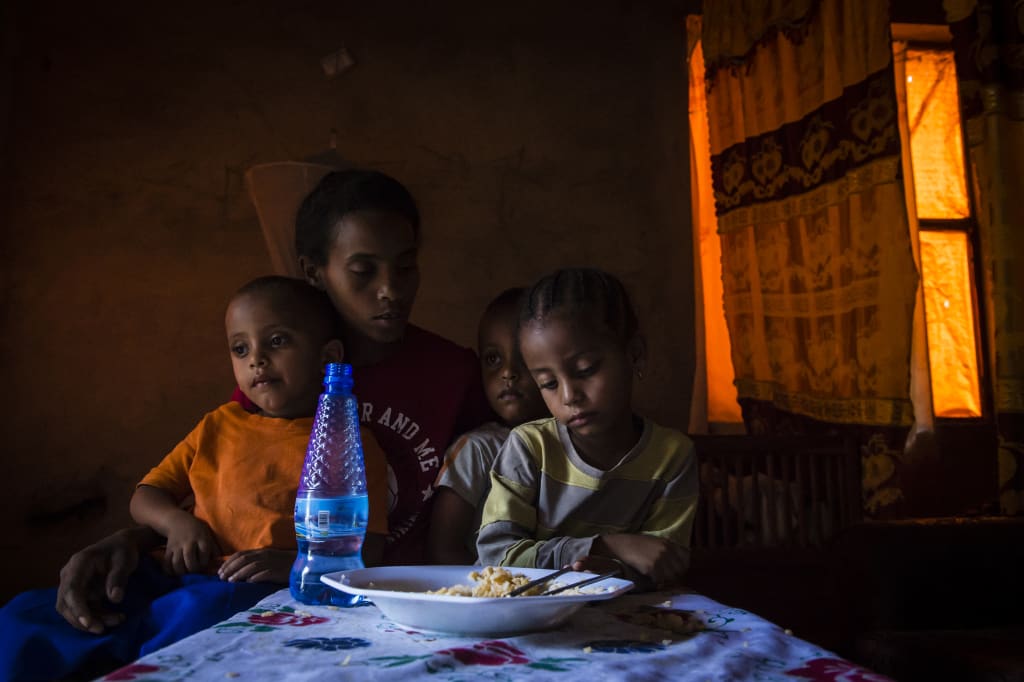
Emebet and her three young children sit at the table together in Ethiopia.
5 reasons the why world is facing a global food crisis
1. Conflict is creating hunger
Conflict is the biggest driver of hunger globally, responsible for 65 per cent of people currently facing hunger and food insecurity. “Conflict tears families, communities, infrastructures, food systems and entire regions apart,” says Santiago ‘Jimmy’ Mellado, CEO of Compassion International.
Conflict pushed 139 million people in 24 countries into acute food insecurity in 2021, up from 99 million in 2020. (Global Network Against Food Crises)
2. The impact of the war in Ukraine
For the global food supply chain, there are few worse countries to be at war than Russia and Ukraine. Together, the two provide almost 30 per cent of the world’s wheat—plus barley, sunflower seed oil and corn—feeding billions of people. This war is tipping our fragile world towards mass hunger, reports The Economist.
Meanwhile, Russia and Belarus are also two of the world’s top producers of potash, an ingredient in fertilizer. Farmers worldwide are affected. With Russia’s exports blocked by many countries, and Ukraine’s planting season impacted by the fighting, a huge supply of the world’s food is trapped or disrupted.
According to The World Bank, this hits low-income countries the hardest, as they depend on food imports the most.
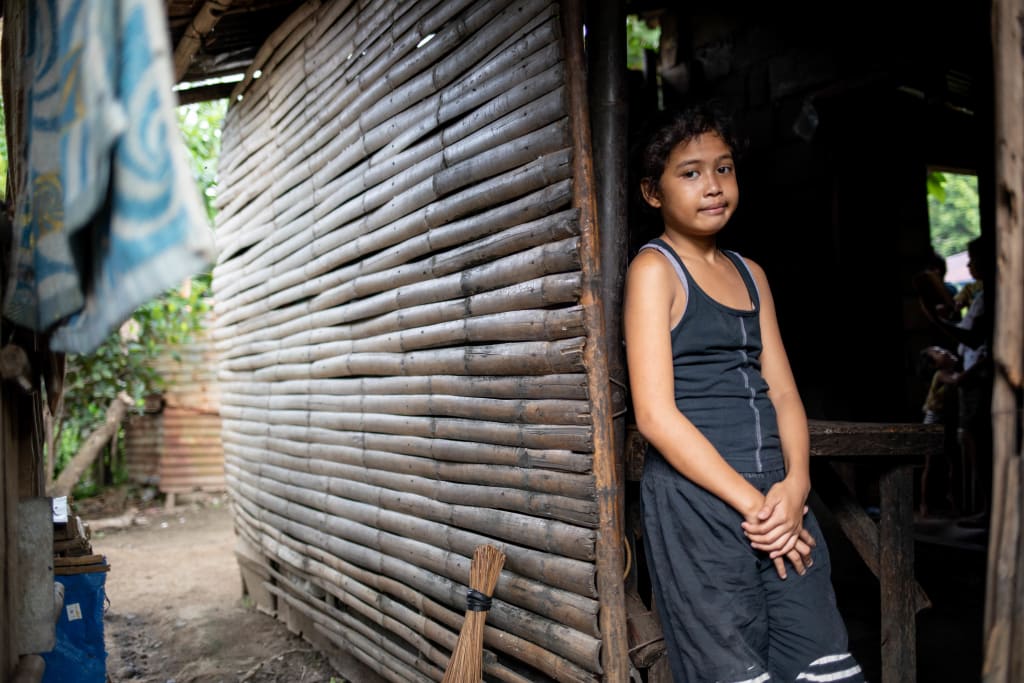
Jamaica stands in the doorway of her home in the Philippines.
3. The rising cost of living
Food has suddenly become very expensive. Trips to the supermarket and the gas station cost a lot more—up to one-third and two-thirds more, respectively, according to the United Nations.
With families in emerging economies spending an average of 25 per cent of their budgets on food—up to 40 per cent in sub-Saharan Africa and 60 per cent in Haiti—the rising cost of living could place households with children in life or death situations. “Food price increases are having devastating effects on the poorest and most vulnerable,” says World Bank Group President David Malpass.
4. Extreme weather and drought
Extreme weather—like hurricanes and droughts—is increasing global hunger by shrinking harvests and skyrocketing food prices. Many of the world’s hungriest countries rely on agriculture as their main industry and eat seasonally according to their harvest. This means that when there is no harvest, there is often no food.
The Horn of Africa is in the grips of a severe drought after three rainy seasons have failed to materialize. Imagine your entire income being dependent not on your hard work or experience, but on the weather. Imagine three years of income wiped out because it didn’t rain.
5. The effects of the pandemic
The impact of COVID-19 pushed more people into poverty. Lockdowns devastated family livelihoods, the economy and disrupted supply chains. The result left 1 in 8 people severely food insecure. Two years later, these families are still struggling to put food on the table.
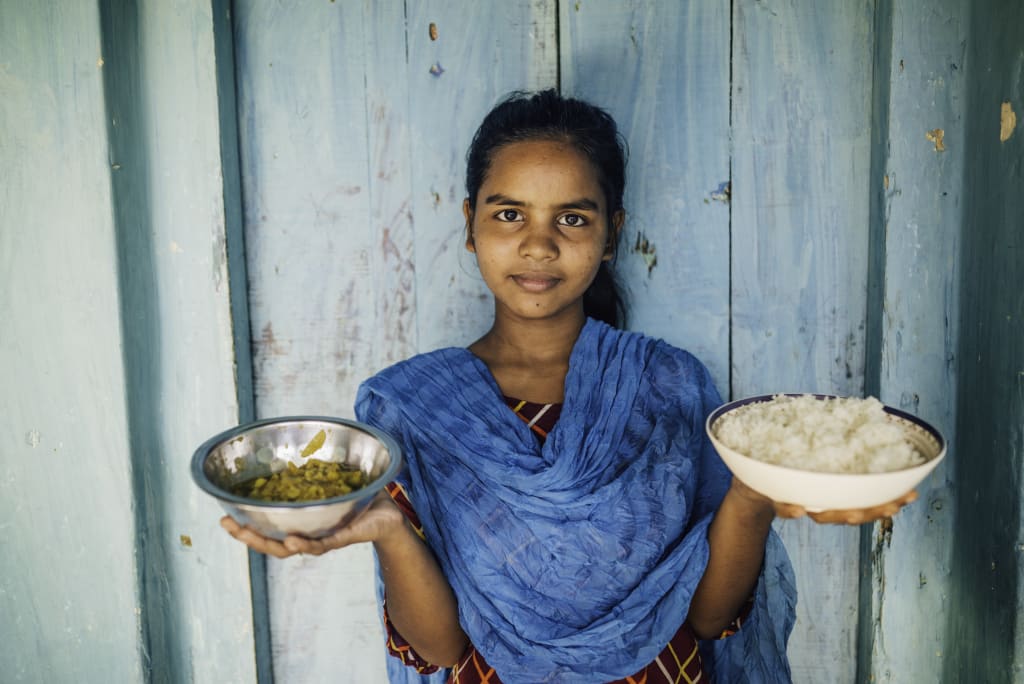
Bobita’s family in Bangladesh received emergency food packs.
4 ways the global food crisis impacts children
1. Food insecure households can create environments of stress and trauma.
This can lead to increased domestic violence, depression, caregiver substance abuse and post-traumatic stress disorder. This puts children at risk of child protection concerns. Many families will go into debt, taking out high-interest loans that will continue to hurt their financial situation over time.
2. Food insecure households compromise education.
While education is one of the most powerful tools to fight poverty, short-term survival often forces families to pull their older children from school to send them to work, to help pay for household expenses. Hunger also contributes to poor academic performance and intellectual development. There is also an increased risk of child labour as children leave school to support their families.
3. Food insecurity poses serious risk to girls.
Gender-based violence and abuse rates increase with food insecurity, as does gender inequality. Girls could be forced to marry early to secure a dowry for their parents. These children are also at a higher risk for activities that may involve sexual or criminal exploitation. When food is scarce, girls often eat less and eat last. Women and girls already account for over 70 per cent of the world’s hungry—how much that will increase will depend on how long this crisis lasts.
4. Hunger contributes to serious health issues.
Hunger causes vulnerability to life-threatening illnesses and, sadly, can even cause death. Nearly half of all deaths in children under 5 are attributable to undernutrition; undernutrition puts children at greater risk of dying from common infections, increases the frequency and severity of such infections, and delays recovery. (UNICEF)

Leonel from Peru eats his vegetables.
3 Scriptures that motivate us to feed the hungry
1. Matthew 25:35-40
“’…For I was hungry and you gave me something to eat, I was thirsty and you gave me something to drink, I was a stranger and you invited me in, I needed clothes and you clothed me, I was sick and you looked after me, I was in prison and you came to visit me.’
Then the righteous will answer him, ‘Lord, when did we see you hungry and feed you, or thirsty and give you something to drink? When did we see you a stranger and invite you in, or needing clothes and clothe you? When did we see you sick or in prison and go to visit you?’
The King will reply, ‘Truly I tell you, whatever you did for one of the least of these brothers and sisters of mine, you did for me.’”
2. Isaiah 58:6-10
Is not this the kind of fasting I have chosen: to loose the chains of injustice and untie the cords of the yoke, to set the oppressed free and break every yoke? Is it not to share your food with the hungry and to provide the poor wanderer with shelter—when you see the naked, to clothe them, and not to turn away from your own flesh and blood?
Then your light will break forth like the dawn, and your healing will quickly appear…If you do away with the yoke of oppression, with the pointing finger and malicious talk, and if you spend yourselves on behalf of the hungry and satisfy the needs of the oppressed, then your light will rise in the darkness, and your night will become like the noonday.”
3. 1 John 3:16-18
“This is how we know what love is: Jesus Christ laid down his life for us. And we ought to lay down our lives for our brothers and sisters. If anyone has material possessions and sees a brother or sister in need but has no pity on them, how can the love of God be in that person? Dear children, let us not love with words or speech but with actions and in truth.”

8-year-old Dana was diagnosed with wasting—a life-threatening form of malnutrition. But her Compassion centre began providing food packs with nutritious foods and she has overcome malnutrition.
2 ways Compassion is responding to the global food crisis
1. Partnering with the local church
Compassion can respond to the global food crisis efficiently and effectively because we partner with the local church. We partner with over 8,500 church partners across the globe who are in the trenches of this crisis. This presence amidst disaster and crisis means that children, their families and communities experience both the hope and help of the local church in real time.

Compassion alumnus Francisco volunteers at the Compassion centre and helps serve a meal to the children. He knows each child by name.
“Our church partners on the front lines of poverty are seeing rising food costs, failing crops and malnourished children. They’re seeing it before it’s in the news. Because our staff are serving children before disasters, during disasters, and they stay after the disaster.”
Palamanga Ouali, Vice President of Africa Region
“What makes the church a good partner is that the church is actually part of the community. They are truly experiencing everything the community is experiencing. So, the level of understanding of who is in need and what level of need—the church has got all that. The church has the ability to mobilize the community in ways that few other organizations can do. They have the structure. They have the names. They know the context of every family and every child in ways that even governments don’t. And so, the church is able to respond appropriately and urgently to meet the very unique needs of each family and child in the program. And that is unique to Compassion.”
Sidney Muisyo, Chief Program Officer
2. Strategic short-term emergency response and long-term sustainable interventions
Working with the local church is a huge advantage in responding to a complex crisis like the global food crisis. One of the many reasons for this is that the local church can meet the urgent and desperate needs of families immediately while also establishing long-term and contextual solutions for families in poverty who live in the same communities that they do.
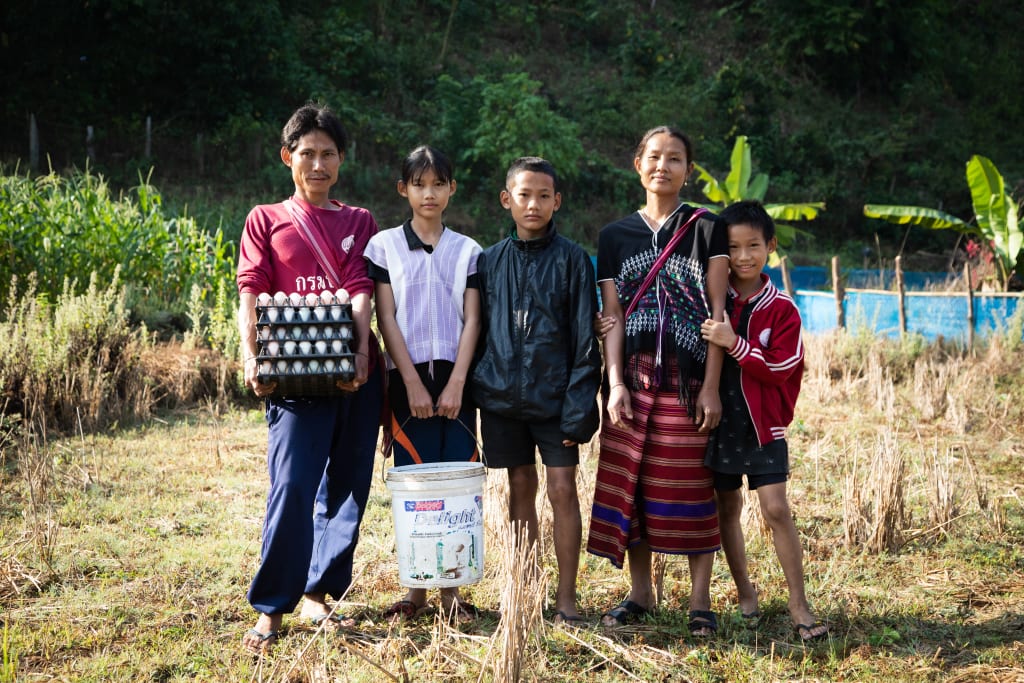
Alongkorn’s Compassion centre has helped his family develop their rice paddies into an agriculture and livestock farm to provide long-term sustainable food and income. Now, they have more than enough and even share with others.
“National offices are responding to the crisis through a mixture of short-term [relief distribution] and medium to long-term interventions, such as supplying caregiver farmers with improved seedlings and other farming or agricultural inputs, building an alternate income generation capacity of Compassion youth households, vocational skill training, and backyard gardening, among others. This approach ensures that families in crisis have food to eat and also have the ability to undertake farming or livelihood activities in the medium to long-term.”
Palamanga Ouali, Vice President of Africa Region
“We have to be thinking long-term about what food security actually means. Food is a basic essential for any child and youth to grow and live. The beauty of Compassion is that we have a long-term development perspective. We do relief, but we are a development organization. That means sustainability for the children and their families is at the core of our program interventions. It’s not merely a question of just providing food today.”
Sidney Muisyo, Chief Program Officer

Darlin beat malnutrition because his Compassion centre helped provide nutritious food for him and his family.
Hope enters the story
Thamilselvi’s sons, Vishal and Vengadeshwaram, are sponsored children at the local Compassion centre. Thamilselvi sees her children being a part of the Compassion program as a gift. During this crisis, Compassion is helping to put food on the table when her family doesn’t have an income. Whenever the two boys go to the centre, they get a good meal.
Compassion implemented a crisis response plan. Part of this plan was the distribution of food packs to the families of sponsored children.
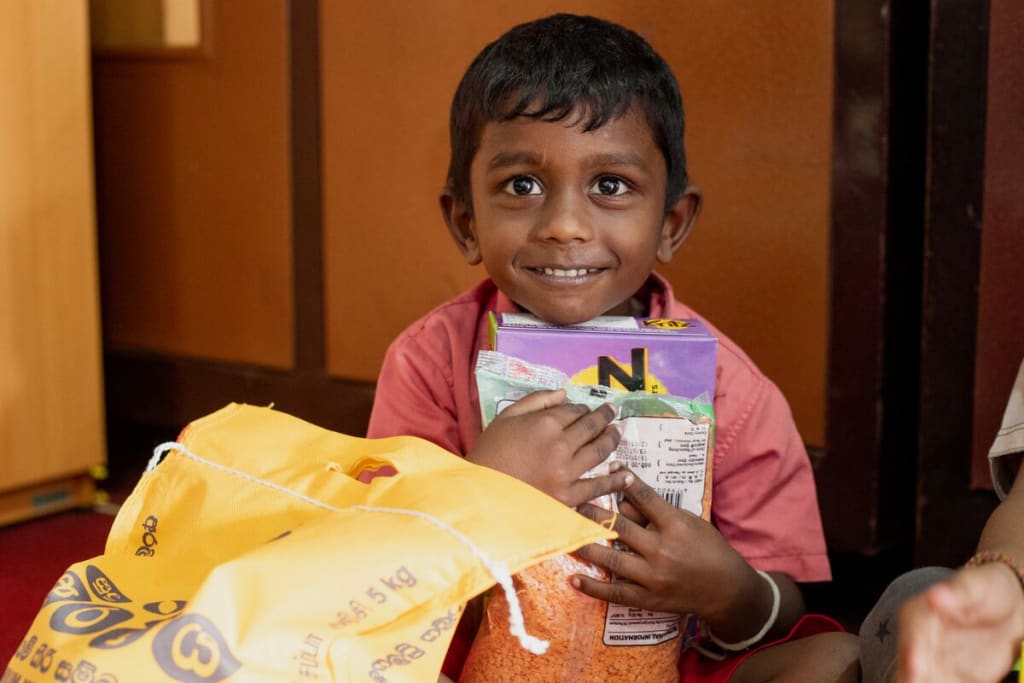
Thamilselvi’s son Vishal smiles as he opens their family’s food pack.
“We requested ration packs for all families,” says Ayanka, Compassion Sri Lanka Senior Manager of Partnership. “We heard that so many people were thankful to receive the packs. Inside them were basic food rations and some hygiene items. The families were really appreciative…they had food on their tables.”
Compassion’s crisis response plan addresses not only the physical concerns, but also the mental, social, and emotional needs of the families and partners.
“We have to build resilience,” says Ayanka. “We have to build families to face this time and also come out of it stronger.”
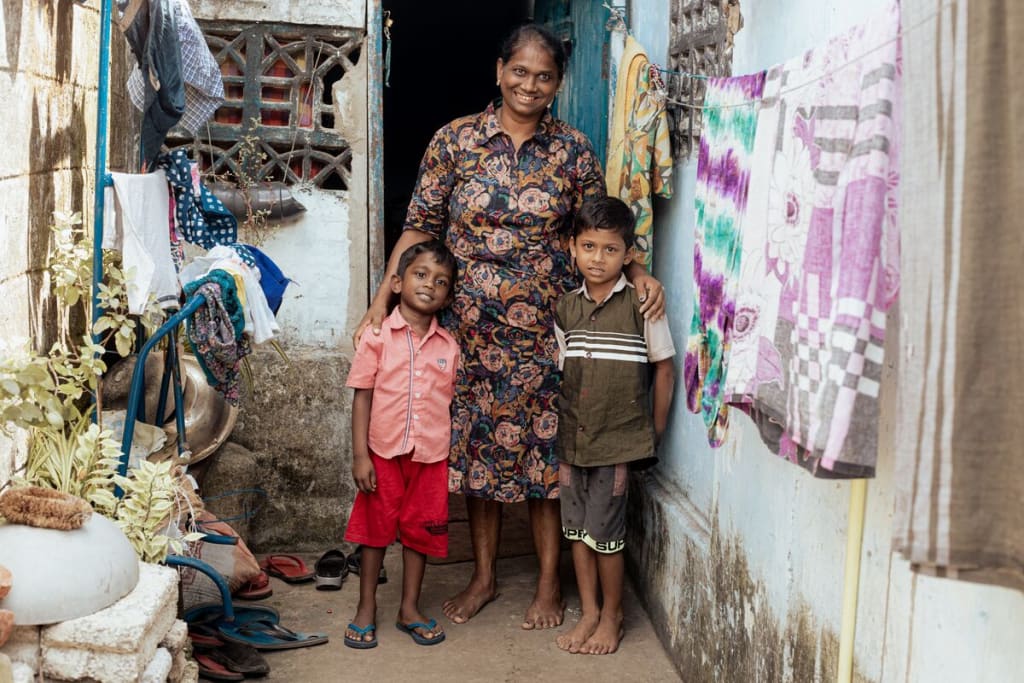
Thamilselvi stands with her two boys, Vishal and Vengadeshwaram.
The Compassion centre staff are determined to help all the families that are part of the program, including Thamilselvi’s. And this has inspired hope in her heart.
“Even though there’s so much difficulty, I have hope,” Thamilselvi says. “In my heart, I have hope. I know after all this, something good will come. We can’t just say it’s difficult and die. We have to face the challenge.”




